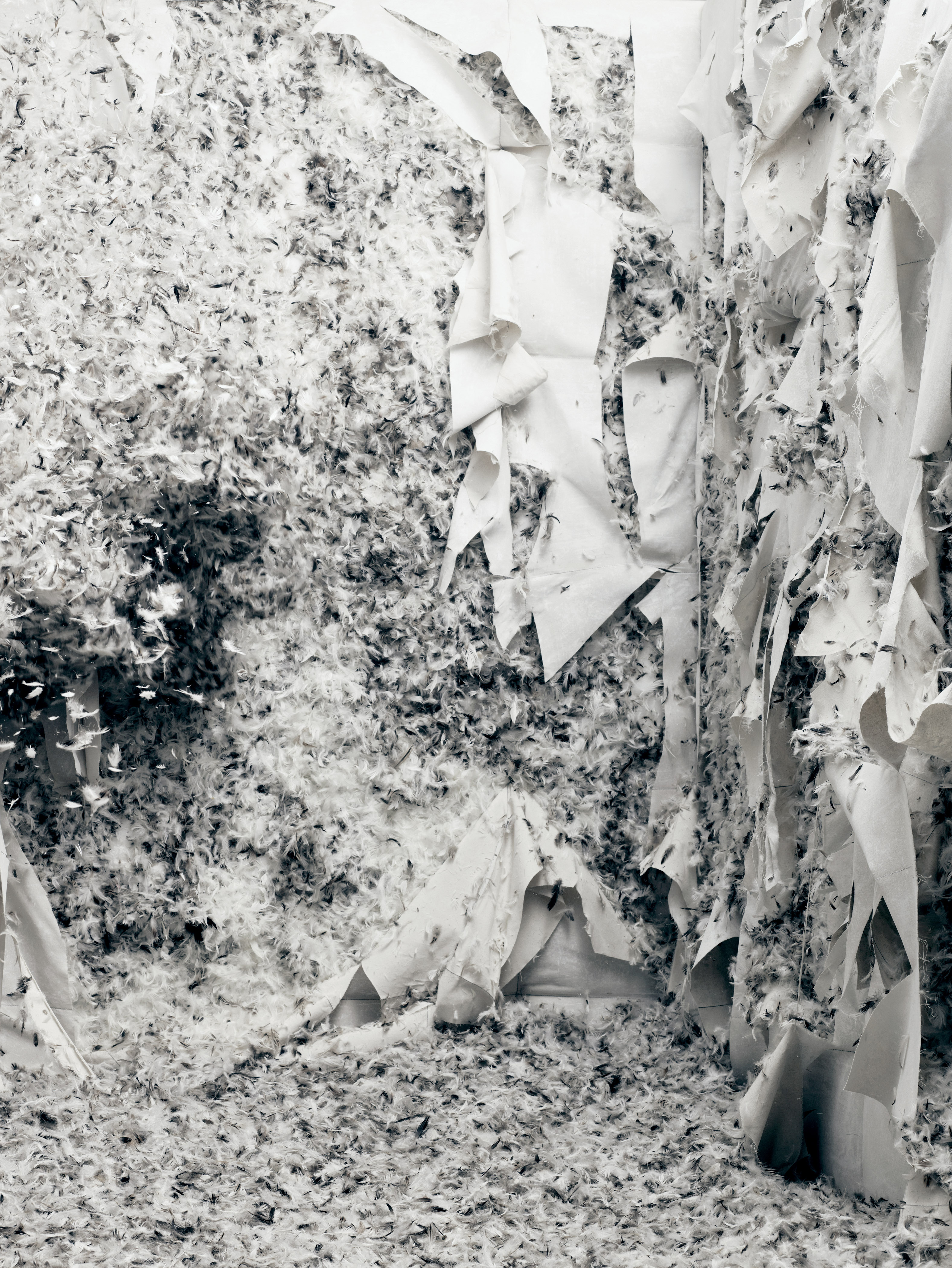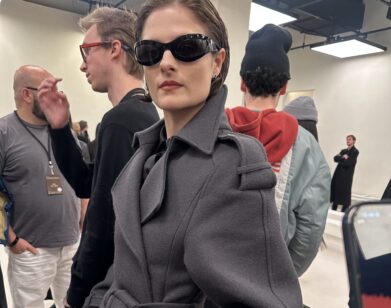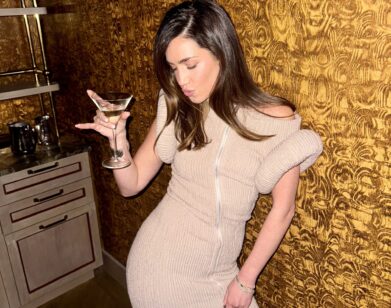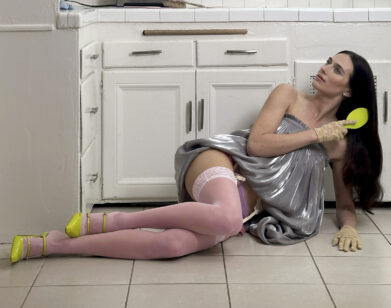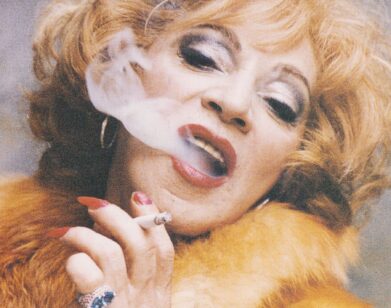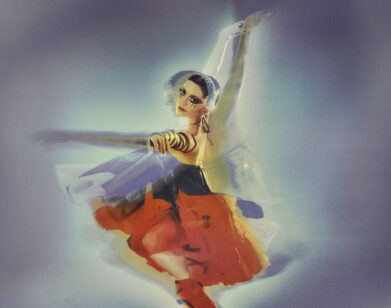Maison Martin Margiela
Since 1988, Maison Martin Margiela has been exacting its own intelligent revenge on the ordinary inseams of high fashion. Celebrating 20 years this fall, the maison is still light-years ahead of its time.
Who better to talk with the mysterious conceptual design house than the originator of conceptual art, Joseph Kosuth? Maison, meet studio.
Twenty years ago, when Martin Margiela started his own womenswear label (his menswear arrived 10 years later), it was as though the Belgian designer counted the brain as part of the human figure. Ever since, the collections have seemed to push and strain and, in some cases, rip apart, resew, and beat up the very definition of clothing. Ironically, as the line has become more and more celebrated, the man himself has slipped farther from the spotlight, eventually disappearing behind the label entirely. Today, it’s the -Maison that does the talking, so it only made sense for us to ask the innovator of conceptual art, Joseph Kosuth, and the team at his studio to take on their intellectual counterparts in the fashion industry. The Maison, made up of 71 employees located in Paris, exchanged a series of e-mails with the Studio, comprising roughly 15 assistants split between Rome and New York, plus Joseph Kosuth himself. The two collectives discussed what they would build if they were architects, why all the greatest contemporary artists are women, the upside of anonymity, and how ripping apart a few 1950s ball gowns can make people really upset. An exhibition this September at the MoMu in Antwerp explores the themes and concepts running through the collections. But here’s our own happy anniversary to Martin Margiela-wherever you are.
JOSEPH KOSUTH STUDIO: In an interview, Marcel Duchamp was once asked the difference between sculpture and architecture, to which he responded, “Plumbing.” We would begin by asking Maison Martin Margiela: In which way would you define the similarities between your
activity and that of an architect? If, for example, you and Frank Gehry traded jobs for a season, would the result of his production be more like his last building or like your last season? Would the outside of your building reveal how the building-or a building-is made? Would the psychological experience of the person living in it be similar to that of one who wears your clothes?
MAISON MARTIN MARGIELA: Marcel Duchamp always had such clever and funny answers! We wish we could answer “Plumbing” too, but this is such an interesting question that we have to find a proper answer. We think the most important similarity between fashion and architecture is that they share the same starting point: the human body. Both disciplines have a function of protecting-if not sheltering-the body, the flesh, and skin, itself. Then, regarding the process, fashion designers and architects both have to think in terms of proportion, structure, volume, and material. It’s interesting that you picked Frank Gehry for the trading game, because he’s often called a deconstructivist, though he claims no formal alliance with any particular movement-just like us! We have no idea what his production would look like, but we’d be immensely interested in seeing it. About our building, your suggestion of the outside referring to its production process would for sure be part of the project. Also, why not a building made out of other buildings? A replica of an existing building? An invisible building that would use the trompe l’œil technique to disappear into the city landscape? What about your building? We’d love to see you trading jobs with Jean Nouvel! You’ve already done some interventions, including architecture, like your incredible Figeac work. But what would the building actually look like that you conceived? Could someone live in it? Or dream about it?
Did you ever consider just buying up in bulk the clothes of your peers and competitors from discount outlet stores and reworking them into your own designs? Your wearers could then see themselves, maybe even admire themselves, as part of an archaeology of fashion references.Joseph Kosuth Studio
JKS: You guessed right on that. As a project, we once proposed for the Milan train station a replica of the station itself. The work was to be located in the piazza right in front of the station. The station is really a monstrous, muscle-bound piece of architecture that overwhelms anything smaller that you’d want to put in front of it. So we thought the only thing neutral enough to create a space in which its own meaning could be seen was to make a miniature of the station. We care about form only when we have to fight form with form. Then we had a white neon quote about travel by the writer Alessandro Manzoni going around the inside of the miniature station. The viewers-including children, we thought-would look into the windows of this replica. Unfortunately, this proposal didn’t win, and the one that did has since been removed by popular demand. But, yes, architecture has been important to our work for a long time. It is one of the ready-made elements that provide a kind of syntactic order that puts the meaning of our work into play. It’s also interesting to recycle historical elements that generate new meanings by the altered context. Something like 20 years ago, along with a lot of other artists like Donald Judd, Dan Flavin, and Cindy Sherman, we were asked by Artes Magnus to design a set of china to be produced in Limoges. We found out that all the diversity of china offered in the history of Limoges came down to six basic designs. So we took each original classic version and added the title and year in type to each. They were then mixed and used as a kind of retrospective of the history of form in Limoges. Here’s a question: Did you ever consider just buying up in bulk the clothes of your peers and competitors from discount outlet stores and reworking them into your own designs? Your wearers could then see themselves, maybe even admire themselves, as part of an archaeology of fashion references-here’s a bit of Prada, here’s a bit of Yamamoto, here’s a snippet of Gucci.
MMM: You asked the right question! This has been part of our creative process since the beginning. From very early on, we came to the point where we realized that, in addition to our main line, we wanted to do something more than take our creative ideas and develop them through an industrialized process. That’s why we launched our Artisanal line. Its concept was-and still is-to reconstruct new garments by using other garments or accessories, used or new. For example, one day we found a great stock of ’50s ball gowns in a flea market. They were cut for the morphology of that epoch-extra-thin waists-and were absolutely unwearable 40 years later since proportions, as well as fashion, have changed so much over time. We decided to cut them, open them in the front, and tie them together with ribbons. In the end, we presented them worn over a T-shirt and a pair of jeans. At the time-it was around 1990-people were horrified and talked about our lack of respect for old garments. But for us, it was just the contrary: It was all about giving a new life to old and abandoned pieces, so they could be worn again in a different way. We’ve always loved this idea you’re talking about: creating garments out of other designers’, as part of an archaeology of fashion references. But did you know that Andy Warhol already did it in 1975? They were known as “composite dresses.” Look how amazing it was! He went even as far as sewing all the labels together on the neck-brilliant! Speaking of archaeology, Michel Foucault said in The Archaeology of Knowledge, “I am no doubt not the only one who writes in order to have no face. Do not ask who I am, and do not ask me to remain the same: Leave it to our bureaucrats to see that our papers are in order.” Considering we’re signing this interview as Maison Martin Margiela and you are as Joseph Kosuth Studio, what do you think of this quote?
JKS: And you provided the right quote! In an economical use of words, Foucault describes the situation. Ha! But be careful-if we begin a duel with quotes, know that Joseph Kosuth Studio is on its home turf. The response to your quote is, understandably, the following quote from Nietzsche: “But how could we possibly explain anything? We operate only with things that do not exist: lines, planes, bodies, atoms, divisible time spans, divisible spaces. How should explanation be at all possible when we first turn everything into an image, our image! It will do to consider science as an attempt to humanize things as faithfully as possible, as we describe ourselves more and more precisely. Cause and effect: Such a duality probably never exists. . . . An intellect that could see cause and effect as a continuum and a flux and not, as we do, in terms of an arbitrary division and dismemberment, would repudiate the concept of cause and effect and deny all conditionality.” Andy Warhol is the source of much. The conversations J.K. had alone with him remain, for him, fixed. Did you know that right now in Stockholm, at the Moderna Museet, we’ve installed a permanent work; half is on the façade of the museum-a bit down from the Rauschenberg logo-and the other is in the main hall. It is part inside and part outside. They also assembled a small show originally intended as the bridge to the big Warhol show that just finished, which documents J.K.’s relationship with Andy. The two traded works in the early ’70s. Andy did J.K.’s portrait-two versions actually, J.K. has one and Elle Macpherson, the other-and J.K. gave him One and Three Shadows. This was a work that was difficult for the collectors-the few we had then-because there was no “object.” But after being initially surprised, Andy liked it and eventually did a series of paintings. Also, there is the J.K. work using a quote of Andy’s, which he took from the Warhol Moderna Museet catalog, now seen as a classic, in the late 1960s. What’s clear is that Andy understood that all of the meaning produced by an artist was put into play and mattered. The part that got called art was more a verb than a noun. Here’s the question: If one’s creative activity is framed by the way that activity is put out in the world-the advertising, the staging of the runway presentation, how the clothing is presented in magazines, and so on-how do you think the anonymous character of Martin Margiela has affected the approach toward the production, and was that intended?
What Martin Margiela looks like has, for us, little or nothing to do with this process. We prefer that people react to a garment through their taste and own personal style and not their impression of the individual or group who created it.Maison Martin Margiela
MMM: We try to have people accept the fact that the work of the Maison Martin Margiela can exist independently of what the designer looks like-that our work is solely a proposition of wearing what it is we like to create, a presentation of a way in which we see things at a given moment. Martin Margiela decided not to appear in the public eye for that reason. He wants the light not to be on him but on what really matters-the clothes, the philosophy, the Maison, the team. And now it’s become the landmark of the Maison. But what some consider a marketing strategy and a sort of snobbism is more like a sacrifice: He could have all eyes on him, and the glory and the fame. But instead he decided to step away, to let the garments and the Maison speak for him, for his love of what he does, and for the respect he has for his team. If people are touched and like to wear what we propose, then they are free to buy and wear it. What Martin Margiela looks like has, for us, little or nothing to do with this process. We prefer that people react to a garment through their taste and own personal style and not their impression of the individual or group who created it, as translated and hyped by the press. Unlike actors or singers, we do not need his physical form to express our work. The Maison Martin Margiela should exist independently of who he is, what he looks like, and any answer he, as an individual and member of a team, may have to any question not directly linked to the clothes. As for the quotes, even though we usually do not refer to specific people to explain our work and our intentions, we cannot deny the fact that the works of some artists have definitely been an influence or a source of inspiration, whatever way you want to call it. Andy Warhol’s work and persona have undoubtedly been very stimulating. As a fashion house we feel it necessary, humanly and creatively, to listen, watch, smell, and touch other visions and interpretations, to inspire us and help us define our own. Any form of creation needs sources of inspiration, whether they come from everyday life, a work of art, a person, a landscape . . . The human body as the structure of the garment is something we have been exploring for quite some time now. But fashion is a craft, a technical know-how and not, in our opinion, an art form. Each world shares an expression through creativity, though through very divergent media and processes. To our mind the work of a fashion designer is so different from that of an artist! We usually work in a necessarily more collaborative manner. We present our work twice a year, using the same medium, respecting the same human form, within an industrial framework, using industrial means of production, and having our work translated through the chain of distribution for our work. Artists are freer to determine the medium with which they choose to express themselves, the intervals at which they present their work, the means by which they produce their expression, as well as the way in which it is sold. And this is what brings our question: From your approach, where would you set the limit between what you do and what we do-that thin red line that divides us?
JKS: What you say makes sense. It’s very much in keeping with the nature of an activity you have called collaborative. We have no doubt that this has a positive effect on the work atmosphere at Maison Martin Margiela, and it also would seem to put more of a focus on the actual production-the clothing-than a focus on the personality would permit. If one takes the other extreme, say, a fashion line by Paris Hilton, where all you have is a personality-theoretically!-and where the clothes don’t really even matter since they are little more than wearable celebrity signatures, your point becomes all the more clear. It might be a bit of a stretch for some, but this is, at least in part, inherited from art history’s monographic tradition, where the expressionist model of the artist evolved from our Judeo-Christian idea of the Messiah, and we got stuck with the notion of the artist as a Christlike shaman, a kind of witch doctor whose marks represented a magical idea of profundity, be it drips, scratches, or erratic personal behavior. Indeed, the traditionalists in the art market still want to see the work of art as though it were a fragment of the true cross! However, the marketing of aura has its limits, and the uniqueness that gives us such market scarcity and real historical quality, reflecting quality of thought, became increasingly at odds. If you think about it, with this Christlike concept of the artist internalized in the culture, no wonder women have had such a hard time being taken seriously as artists. When did this change significantly? Well-we say proudly!-with the advent of conceptual art, because by providing another basis for our concept of art, quality became defined by a criterion based on the quality of thought that the artwork manifested, how authentically it reflected our own time, what it added to the body of ideas about art and life that forms our consciousness. One’s contribution as an artist then, once separated from the gender-based expressionist package, became increasingly judged only by the quality of the contribution. As a result, we see that the majority of the best artists are now women. The art market of the 1980s and ’90s, for example, had us believe that the works that mattered were those big phallocentric paintings made by some of those boys often celebrated between these pages-but actually, the pieces that history will probably care more about are mostly photographs, and they were made by women. But to return to your question to me, “Where would you set the limit between what you do and what we do-that thin red line that divides us?” Our answer would be the following: Without suggesting that, by necessity, either of our activities is more creative than the other, because we don’t believe that they are, we think the difference is to be found in how we must define limit for ourselves within the practice of what we do. Yesterday, in a different interview, we gave the following as part of the answer to a question about the difference between art and philosophy. We said, “Art both questions signification itself and does so as a signifying activity. It posits apparent limits, which, by the nature of its activity, then vanish. Within the space of those two transitory points, we find a lot to do, and some of it depicts-and some of it (momentarily) defines-reality, but it can do so in a transformatory way.” The relative fixity of the limit of your limit is also its power and importance: The shelter that it provides us as it also locates us within our culture means that, not unlike for any artist, you define yourself by how you play with your limit. And that’s just as it is for architecture. So we end this conversation just where it began.
MMM: Let us know if you want to continue this conversation when you celebrate your next significant anniversary, and you are more than welcome to join us to celebrate ours at our next show in Paris, where once again we will be playing with our limit.

